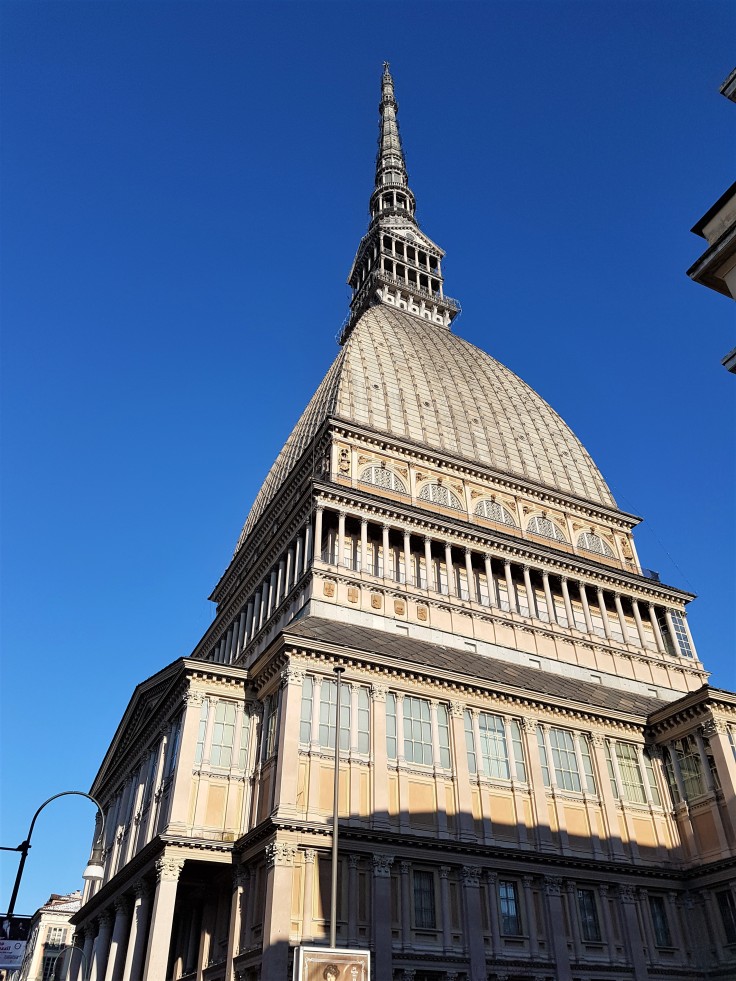During my afternoon in Turin, I’d decided to visit Turin’s tallest building, the Mole Antonelliana, as well as the city’s renowned Egyptian Museum.
So after having a spot of lunch, I wandered along Turin’s elegant covered streets, past lots of shops and cafés, on my way to the Mole Antonelliana.

The Mole Antonelliana (above) is an enormous late 19th century building with a 550ft spire – in its heyday, it was the tallest brick building in Europe.
It was designed by the architect Antonio Antonelli in the 1860s when he was commissioned by Turin’s Jewish community to build them a synagogue.
As Antonelli’s plans became more elaborate and the costs spiralled, the Jewish community pulled out of the project and the city of Turin took over. The Mole Antonelliana was finally finished in 1889 and today is home to the National Museum of Cinema.
The Mole Antonelliana is a stunning building with an unusual and distinctive shape. You can take a panoramic lift to a viewing platform, which is 278ft from the ground, and I was keen to do this until I saw the queue and the hour-long wait for it.
As I was planning to visit the Egyptian Museum before I left, I didn’t think I had time to do both so I skipped the viewing platform, even though the views across the city and the Alps must be incredible.

From the Mole Antonelliana, I walked through Turin’s streets to the Egyptian Museum, which is housed in a gorgeous palazzo-style building in the centre of the city (above), admiring the sights and window shopping as I went.
Turin’s renowned Egyptian Museum is the only museum outside Cairo dedicated to ancient Egypt and boasts the second largest collection of ancient Egyptian artefacts in the world.
Only a fraction of the museum’s 32,500-piece collection is on display, with some 6,500 artefacts on show and the remaining 26,000 in storage.
I visited in early December 2017 and there was an interesting temporary exhibition on the ground floor about the men and women who were responsible for amassing, curating and preserving the museum’s collection.
It was interesting to read about the people behind the collection, their motives for collecting the artefacts and the impact it had on their lives.
So often you visit museums or art galleries and admire the amazing objects within, but it’s rare to learn about the people responsible for those collections.
From there, I followed the visitor route around the museum. Starting on the second floor, it told the story of ancient Egypt from its prehistoric origins all the way through to the later dynasties of pharaohs.
There were lots of artefacts on display, the most impressive being the scrolls from the Book of the Dead. They looked as good as new – the colours were vivid and not at all faded, and it was hard to believe they were thousands of years old.
I would have loved to have been able to read the hieroglyphics so I could understand what they said.
There were also lots of mummies and coffins (some with brightly painted exteriors), statues, pieces of pottery, steles and more on display, as well as a net made from turquoise beads, which had been found wrapped around a mummy.
It’s an extraordinary and extensive collection, and very well curated. I spent a good two hours looking around the museum and could easily have spent longer as it’s a fascinating place.
One of the more interesting aspects of the museum was the exhibit of material culture on the balcony above one of the galleries on the second floor.
The display brought together lots of similar objects, such as head rests, grave goods and so on, in one cabinet. It was an unusual but effective approach to displaying lots of similar artefacts, and one I’d like to see repeated in other museums.
The only slight downside was the huge number of tour groups who blocked paths and access to the display cases for long periods of time.
I found a few of them quite rude and unwilling to let people past, and it would be good if the museum restricted the number of tour groups it allowed on busy weekends so that all the visitors could enjoy the attractions.
I really enjoyed my day trip to Turin, although I could have done with a lot longer to look around. The few attractions I visited – the royal palace and the Egyptian Museum – were enormous and world-class, with lots to see, and there were many more attractions I didn’t get chance to visit.
A day isn’t long enough in Turin and I could have done with at least three or four days. I’ll have to go back one day to see all the attractions, as well as the parts of the royal palace and the Egyptian Museum, I missed on my whistlestop tour.




